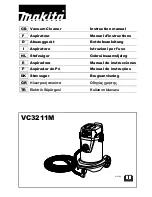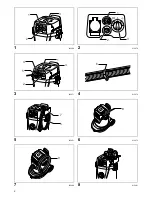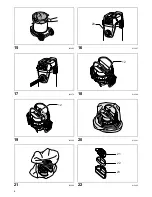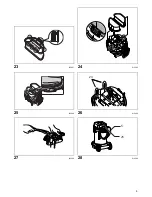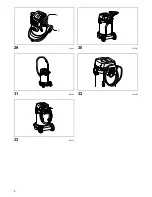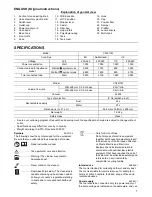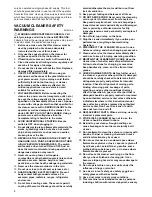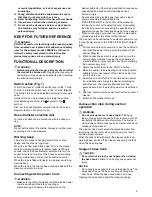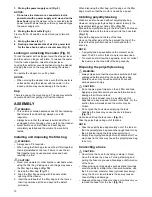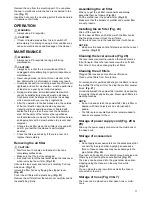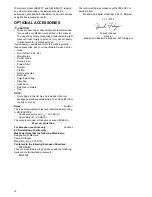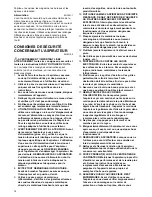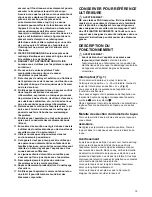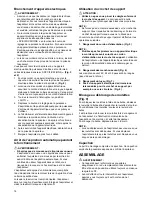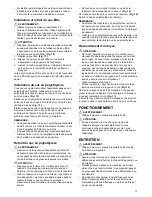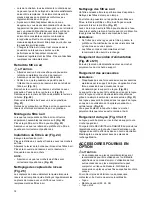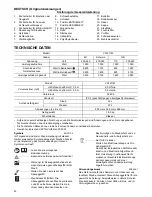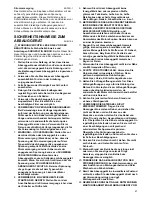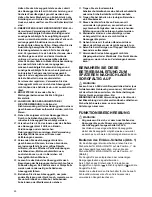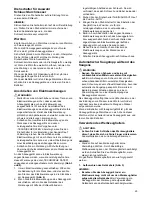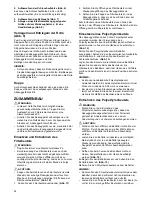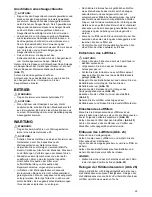
10
1. Storing the power supply cord (Fig. 5)
NOTICE:
•
Do not use the cleaner or a connected electric
power tool with a power supply cord wound on the
base hook.
Using the cleaner or the connected electric
power tool with power supply cord may cause damage
the power supply cord.
2. Storing the front cuffs (Fig. 6)
Front cuffs 22, 24 and 38 can be stored (up to two at a
time.)
3. Storing the hose (Fig. 7)
4. Resting a reasonable size of electric power tool
for the base hook, such as circular saw. (Fig. 8)
Locking or unlocking the caster (Fig. 9)
To lock the caster with a stopper, lower the stopper lever
and the caster no longer will rotate. To release the caster
from the locked position, raise the stopper lever.
Locking the caster is convenient when storing the cleaner,
stopping the work on the way and keeping the cleaner
still.
To operate the stopper, move it by hand.
NOTICE:
• When moving the cleaner, make sure that the caster is
unlocked. Moving the cleaner with the caster in the
locked position may cause damage to the caster.
Cap
There is a cap on the mounting port. The cap prevents the
vacuumed dust from getting out from the cleaner.
ASSEMBLY
WARNING:
• This unit may contain hazardous dust. When replacing
filter elements and dust bag, always use a P2-
respirator.
• Always be sure that the cleaner is switched off and
unplugged before carrying out any work on the cleaner.
• Never switch on until all filters and dust bag are
completely installed and the volume flow control is
tested.
Installing and disposing the filter bag
WARNING:
• Always use a P2-respirator.
• When using the filter bag, also use the air filter together
that is preinstalled on the tool. Failure to use the air
filter together may cause unusual noise and heat,
resulting in a fire.
CAUTION:
• Never pick up water or other liquids or wet dusts when
using the filter bag. Picking up such things may cause
the filter bag breakage.
(Fig. 10)
1. Extend the filter bag.
(Fig. 11)
2. Align the filter bag opening with the dust suction
opening of the cleaner.
3. Insert the cardboard of the filter bag onto the tool so
that it is positioned at the end beyond the detent
protrusion.
When disposing the filter bag, pull the edge on the filter
bag’s mouth so that the mouth is closed by a paper.
Installing polyethylene bag
Cleaner can also be used without polyethylene bag.
However, using polyethylene bag is easier to empty the
tank without letting your hands dirty.
(Fig. 12)
Spread the polyethylene bag in the tank. Insert it between
the holder plate and the tank, and pull it to the hose inlet.
(Fig. 13)
Spread the bag around the top of the tank.
Hook up the other side of the bag around the top of the
tank so that the prefilter hook can catch and hold it
securely.
NOTE:
• A polyethylene bag available on the market can be
used. The 0.04 mm or thicker one is recommended.
• Too much dust will tear the bag easily, so do not collect
the dust more than the half of the bag capacity.
Disposing the polyethylene bag
WARNING:
• Always make sure that the cleaner is switched off and
unplugged before emptying the polyethylene bag.
Failure to do so may cause an electric shock and
serious personal injury.
CAUTION:
• Do not apply a great impact on the air filter and tank.
Applying a great impact may cause deformation and
damage to air filter and tank.
• Empty the tank at least once a day although this
depends on picked-up dust volume in the tank. Or, the
suction force will weaken and the motor may be
broken.
• Do not grab the hook when emptying the tank.
Grabbing the hook may cause the hook to break.
(Fig. 14)
Unhook and lift up the tank cover.
(Fig. 15)
Take the polyethylene bag out of the tank.
NOTE:
• Take the polyethylene bag carefully out of the tank so
that the polyethylene bag cannot be caught and torn by
the protrusion inside the tank when emptying it.
• Empty the polyethylene bag before it becomes full. Too
much dust in the tank may cause the polyethylene bag
to be torn.
Connecting a hose
CAUTION:
• Never force the hose for bending or stamp it. Never
move the cleaner by a hose. Forcing, stamping and
pulling the hose may cause a breakage or deformation
of the hose.
• When picking up large wastes such as planer carvings,
concrete dusts or similar other than small wastes, use
the 38 mm inner diameter hose (optional accessory).
Using the 28 mm inner diameter hose may cause a
hose stuffing and damage.
• Always put the cap on the mounting port whenever you
remove the hose from the tool.
(Fig. 16)
Summary of Contents for VC3211M
Page 5: ...5 23 013837 24 013395 25 014948 26 013464 27 013484 28 013380 24 5 25 ...
Page 6: ...6 29 011634 30 013381 31 013382 32 013486 33 013374 5 7 ...
Page 73: ...73 ...
Page 74: ...74 ...
Page 75: ...75 ...

